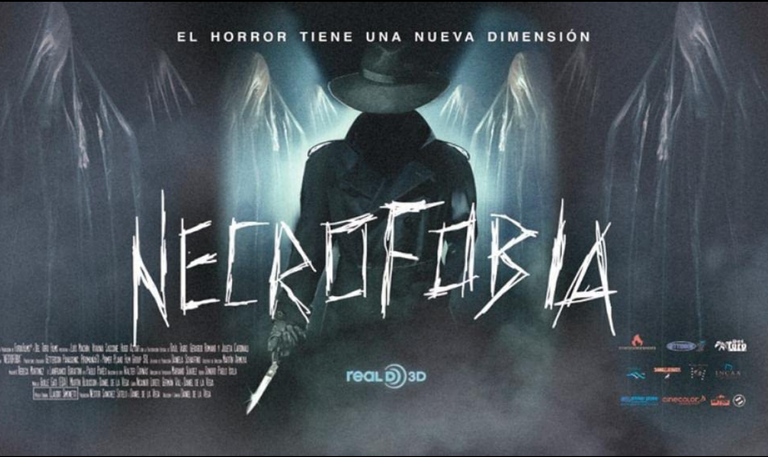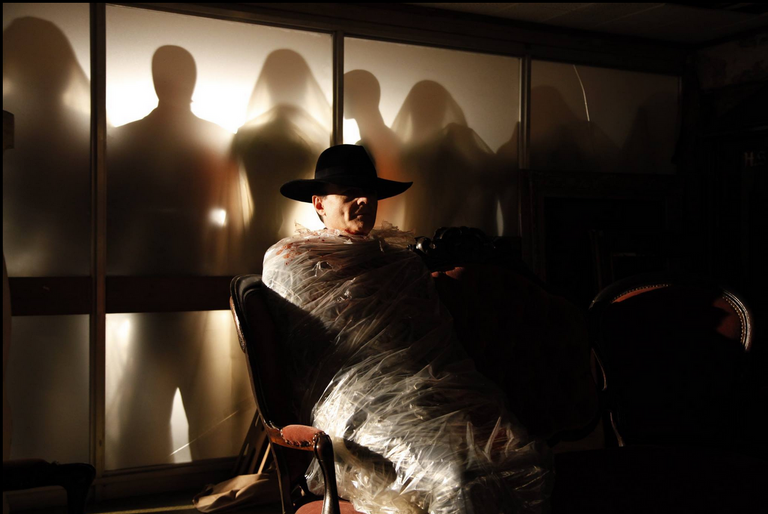Necrophobia is a diverse and life-changing film, review and impressions about it. / Necrofobia es una película distinta y cambiante, reseña e impresiones sobre la misma. [ENG/ESP]

Hello #hivers movie and TV lovers from Movies & TV Show,
today I want to share with all of you my impressions about Necrophobia, a diverse Argentinean film, changing in a certain way but always interesting, whose fear is nothing more and nothing less than the fear of death and specifically of those who represent it, i.e. corpses.
It is not a very cheerful subject to begin with, but, having cleared this initial taboo, I think we can concentrate on the artistic aspects of this film.
The theme of corpse phobia is a subject that the Argentine director Daniel De La Vega deals with in depth in this intense film that enjoys an excellent original soundtrack by the Italian composer Claudio Simonetti, integrating perfectly in that claustrophobic and somber atmosphere that animates the film from beginning to end.
Although on one side the main character is fully identified with one of his mannequins, strong emotions that lead him to real identity crises characterize his human aspect.

Hola #hivers amantes del cine y la TV de Movies & TV Show,
hoy quiero compartir con todos Ustedes mis impresiones sobre Necrophobia, una película argentina diversa, cambiante en un cierto modo pero siempre interesante, que tiene como miedo nada más y nada menos que el miedo a la muerte y específicamente a quienes la representan, es decir los cadáveres.
No es un tema muy alegre para empezar, pero, despejado este tabú inicial, creo que podemos concentrarnos en los aspectos artísticos de este film.
El tema de la fobia a los cadáveres es un tema que el director argentino Daniel De La Vega trata a fondo en esta intensa película que goza de una excelente banda sonora original a cargo del compositor italiano Claudio Simonetti, integrándose perfectamente en ese ambiente claustrofóbico y sombría que anima la película del inicio al final.
Si bien por un cierto lado el personaje principal se identifica plenamente con uno de sus maniquíes, fuertes emociones que lo llevan a verdaderas crisis de identidad caracterizan su aspecto humano.


The world of Dante Samot (magnificently played by Luis Machín) is represented by the noise of a sewing machine and a room full of mannequins covered in cellophane and wrapped in an intense fog (all this dreamlike scenery is part of the identity of the protagonist, a person who spends his time busy making the suit he will have to wear at the funeral of his twin brother Tomás).
The noise of a sewing machine, followed by the image of a room full of cellophane-covered mannequins in his huge tailor's shop, shrouded in a permanent fog, are part of the dream world of Dante, a man busy making the suit he will have to wear at the funeral of his twin brother Tomas.
The tailor's shop is actually not only very large, but also a gloomy and sad place where death is breathed at every step in an environment populated purely and exclusively by mannequins that are not only working elements, but also part of a spectral decoration in which the protagonist is immersed.
One of the best scenes is when Dante puts on his suit to go to the cemetery for the burial of his brother. His face reflects an intense suffering that is transmitted to the soul of the protagonist, in the midst of so many mannequins worn out by time.
The protagonist is not only a seemingly normal and saddened tailor, he is much more than that. He is an ambiguous character whose disturbed personality manifests itself in all its fullness in the sequence of the funeral ceremony in the cemetery, where the omnipresent sensation of death amplified by the presence of his brother's corpse -which had already been verified before in the morgue- provokes in him an uncontrollable relationship, to such an extent that when he is only submerged in the midst of his thoughts in the company of so many tombstones of relatives and friends, he is overcome by a deep panic that takes him to the limit of madness.
The cinematographic story continues with a whirlwind of events that plunge Dante into a labyrinth from which he finds it increasingly difficult to get out and whose end is preventable: delirium, madness and death.
In reality, analyzed coldly and from a perspective that goes beyond necrophobia, the film is a descent into the abysses of hell, of madness in all its aspects.

El mundo de Dante Samot (magníficamente interpretado por Luis Machín) está representado por el ruido de la máquina de coser y una habitación llena de maniquíes cubiertos de celofán y envueltos en una niebla intensa (toda esta escenografía onírica hace parte de la identidad del protagonista una persona que pasa el tiempo ocupado en confeccionar el traje que tendrá que llevar en el funeral de su hermano gemelo Tomás).
El ruido de una máquina de coser, seguido de la imagen de una habitación llena de maniquíes cubiertos de celofán en su enorme sastrería, envueltos en una niebla permanente, forman parte del mundo onírico de Dante, un hombre ocupado en confeccionar el traje que tendrá que llevar en el funeral de su hermano gemelo Tomás.
La sastrería en realidad no solo es muy grande, sino que también es un lugar lúgubre y triste donde se respira la muerte a cada paso en un ambiente poblado pura y exclusivamente por maniquíes que no son solo elementos de trabajo, sino que también hacen parte de una decoración espectral en la cual se sumerge el protagonista.
Una de las mejores escenas es que cuando Dante se pone el traje > para ir al cementerio en el sepelio de su hermano. Su rostro refleja un intenso sufrimiento que se transmite al alma del protagonista, en medio de tantos maniquíes desgastados por el tiempo.
El protagonista no es únicamente un sastre aparentemente normal y apesadumbrado, es mucho más que ello. Es un personaje ambiguo cuya personalidad perturbada se manifiesta en toda su plenitud en la secuencia de la ceremonia fúnebre en el cementerio, donde la omnipresente sensación de muerte amplificada por la presencia del cadáver de su hermano -que ya se había verificado antes en la morgue- provoca en él una relación incontrolable, a punto tal que al quedar solamente sumergido en medio de sus pensamientos en compañía de tantas lápidas de familiares y amigos, lo invade un pánico profundo que lo lleva al límite de la locura.
El relato cinematográfico continuo con una vorágine de hechos que van a sumergiendo a Dante en un laberinto del cual le cuesta cada vez más salir y cuyo final es prevenible: el delirio, la locura y la muerte.
En realidad, analizada fríamente y desde una perspectiva que va más allá de la necrofobia, la película es un descenso hacia los abismos del infierno, de la locura en todos sus aspectos.


Luis Machín as/como: Dante Samot
Raúl Taibo as/como: Nicolás Virgilio
Viviana Saccone as/como: Soledad Roca
Gerardo Romano as/como: Padre Gustavo
Julieta Cardinali as/como: Beatriz Samot

There are many elements to highlight in this film that, despite having a budget far from that of the big Hollywood productions, manages to stand out.
One of them, as already mentioned, is the soundtrack perfectly in tune with the theme of the film: gloomy, somber, distressing.
Also the special effects have a certain significance as the amputation of a hand, the corpse that is cut with scissors, emblematic allusion to the profession of the profession).
And finally it is also a kind of homage to those black and white films of the seventies and eighties in which suspense, horror and anguish depended on the director's skill in handling the cameras rather than on the special effects of the PC, as we are used to seeing nowadays.
Dario Argento, Alfred Hitchcock, David Cronemberg, Brian de Palma himself and many other directors are a perfect example of this.
It is a cinematographic work full of fascination for a subject that we rarely see in the big movie theaters, but it is also an artistic work of great tension due to the bond that is created between the protagonist and the spectator, where the latter ends up being a kind of sponge that absorbs all the anguish that emerges from the film from the beginning to the end.

Hay muchos elementos para destacar en esta película que, a pesar de contar con un presupuesto muy lejano en las cifras al de las grandes producciones hollywoodianas, logra destacarse.
Uno de ellos, como ya se ha dicho, es la banda sonora perfectamente a tono con el tema de la película: lúgubre, sombría, angustiante.
También los efectos especiales tienen una cierta significatividad como la amputación de una mano, el cadáver que es cortado con tijeras, emblemática alusión a la profesión de la profesión)
Y es por último también una especie de homenaje a esos films en blanco y negro del los años setenta-ochenta en los cuales el suspenso, el horror y la angustia dependía de la habilidad del director en manejar las cámaras que de efectos especiales al PC, como estamos habituados a ver en la actualidad.
Darío Argento, Alfred Hitchcock, David Cronemberg, el mismo Brian de Palma y otros tantos directores son una muestra acabada de ello.
Es una obra cinematográfica llena de fascinación por un tema que vemos poco en las grandes carteleras del cine, pero también es una obra artística de gran tensión por el vínculo que se crea entre el protagonista y el espectador, donde este último termina siendo una especie de esponja que absorbe toda la angustia que emerge de la película del inicio al final.

The paragraph separator -adapted- is the property of The Peak Studio to whom I am grateful for the kind permission to use it.
El separador de párrafos -adaptado- es propiedad de The Peak Studio a quien agradezco la gentil concesión de uso.
https://twitter.com/HugoRep/status/1524448232402825216
The rewards earned on this comment will go directly to the person sharing the post on Twitter as long as they are registered with @poshtoken. Sign up at https://hiveposh.com.
Thanks @poshtoken.